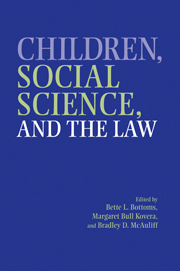Book contents
- Frontmatter
- Contents
- Acknowledgments
- Contributors
- 1 Children, Social Science, and the Law: An Introduction to the Issues
- PART I CHILDREN'S RIGHTS, THEIR CAPABILITIES, AND SOCIETY'S RESPONSIBILITIES TO CHILDREN
- PART II CHILDREN AND FAMILY CHANGE
- PART III JUVENILE AGGRESSION AND JUVENILE JUSTICE
- PART IV CHILDREN AS VICTIMS AND WITNESSES
- PART V CONCLUSIONS AND FUTURE DIRECTIONS
- 17 Starting a New Generation of Research
- 18 What Will It Take to Bring Child-Focused Law, Policy, and Research into the 21st Century? Concluding Thoughts
- Author Index
- Case Index
- Subject Index
- References
18 - What Will It Take to Bring Child-Focused Law, Policy, and Research into the 21st Century? Concluding Thoughts
Published online by Cambridge University Press: 24 July 2009
- Frontmatter
- Contents
- Acknowledgments
- Contributors
- 1 Children, Social Science, and the Law: An Introduction to the Issues
- PART I CHILDREN'S RIGHTS, THEIR CAPABILITIES, AND SOCIETY'S RESPONSIBILITIES TO CHILDREN
- PART II CHILDREN AND FAMILY CHANGE
- PART III JUVENILE AGGRESSION AND JUVENILE JUSTICE
- PART IV CHILDREN AS VICTIMS AND WITNESSES
- PART V CONCLUSIONS AND FUTURE DIRECTIONS
- 17 Starting a New Generation of Research
- 18 What Will It Take to Bring Child-Focused Law, Policy, and Research into the 21st Century? Concluding Thoughts
- Author Index
- Case Index
- Subject Index
- References
Summary
If you've read Children, Social Science, and the Law thus far, you might share my belief that the fiscal and legislative reforms needed to remedy the problems noted by the distinguished authors of these chapters are quite formidable – especially given contemporary political trends. The more we know (and this book has provided a wealth of research synthesis information), the less it seems that critical laws, policies, and practices conform to what, in so many ways, is best for children and their families. Our public systems of intervention for some very vulnerable populations – children in high-conflict parental custody disputes, in abuse/neglect cases, and in the juvenile delinquency arena – continue to fail far too many of them. And we simply have no coherent unifying national children's policies through which proposed new legislation and practice reforms can be evaluated.
In reading these chapters, I sense that we are destined to continue having fragmented, underfunded, and politically expedient approaches to governmental intervention with children and their families (including some poorly thought out laws opportunistically named for deceased children) unless:
Policy makers step back before passing new child-related legislation and take time to learn from the experts what has worked and what has not;
Program models are adequately funded and evaluated; and
Information on successful programs is more widely disseminated so that there can be stronger support for expanding them to serve far more children and families in need.
- Type
- Chapter
- Information
- Children, Social Science, and the Law , pp. 454 - 468Publisher: Cambridge University PressPrint publication year: 2002



